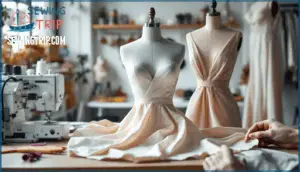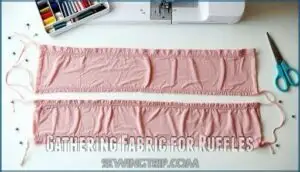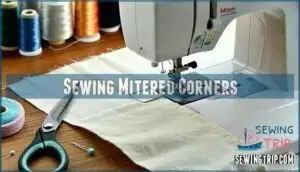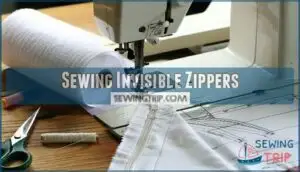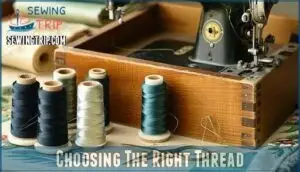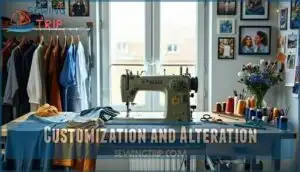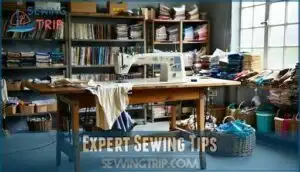This site is supported by our readers. We may earn a commission, at no cost to you, if you purchase through links.

You’ll need sharp scissors, quality thread, and a well-maintained machine with adjusted tension.
Essential skills include hand-sewing basics, installing zippers, and creating professional seams like French or flat-felled finishes.
Pre-treat fabrics before cutting, use appropriate presser feet, and practice gathering techniques for ruffles.
Advanced methods involve working with challenging materials like silk, creating invisible zipper installations, and perfecting mitered corners.
Professional results come from consistent practice and attention to detail—even seasoned sewists discover game-changing shortcuts that transform their technique overnight.
Table Of Contents
Key Takeaways
- Master the fundamentals first – You will build confidence faster by perfecting machine threading, straight stitches, and hand-sewing basics before tackling advanced techniques like French seams or invisible zippers.
- Prepare your fabric properly – You will avoid costly mistakes by pre-washing cotton, cutting with sharp scissors along the grain, and choosing the right thread weight for your fabric type.
- Maintain your equipment regularly – You will achieve professional results by keeping your machine clean, adjusting tension settings correctly, and using specialty presser feet for specific techniques.
- Practice precision techniques consistently – You will transform amateur work into professional-quality pieces by mastering details like mitered corners, proper seam allowances, and invisible finishing methods through regular practice.
Essential Sewing Skills
You’ll build confidence faster when you master these three foundational skills that every seamstress relies on daily.
These core techniques form the backbone of every successful sewing project, from simple hems to complex garments.
Threading a Sewing Machine
Looking at the paragraph about threading a sewing machine, here’s a short engaging blockquote in the same tone:
Master your machine’s threading path—it’s the difference between smooth sailing and tangled disasters.
Master machine threading by following your manual’s path precisely.
Start with the upper thread, guiding it through tension discs and take-up lever before needle alignment.
Load your bobbin correctly—improper bobbin management causes thread tangles.
Test thread tension on fabric scraps first.
Quality thread selection prevents breaks and guarantees smooth sewing machine setup for professional results.
Proper thread tension settings are vital for achieving consistent stitches and preventing machine damage, ensuring a professional outcome.
Hand Sewing Techniques
Hand sewing gives you complete control when machine stitching won’t work.
Master the Running Stitch for basic seams and Hand Gathering for creating ruffles.
The Blind Hem keeps hems invisible, while Whipstitch secures raw edges.
Slipstitch creates invisible seams between fabrics, and these fundamental hand sewing techniques, including the Blind Hem, become your backup when precision matters most.
Straight Stitch Mastery
Every straight stitch begins with proper setup—adjust your stitch length between 2.5-3mm for most fabrics.
Tension control prevents puckering while fabric guidance guarantees seam accuracy.
Choose matching thread selection for invisible results.
Practice maintaining consistent speed and steady hands.
Your sewing machine stitches improve dramatically when you focus on these beginner sewing tips and regular sewing machine care.
Advanced Sewing Techniques
Once you’ve mastered the basics, you’re ready to tackle techniques that’ll make your projects look professionally finished. These advanced skills transform simple garments into polished pieces that rival store-bought quality.
Sewing Scalloped Edges
Creating beautiful scalloped edges transforms ordinary hems into stunning decorative features.
Start by drafting consistent half-circles using a compass on freezer paper templates. Use shorter machine stitches for smooth sewing curves, then trim seam allowances to 1/8-inch and clip valleys carefully.
Press each scallop while shaping for professional edge finishing that elevates any garment construction project.
To achieve a flawless finish, consider using a blind hem stitch technique for your sewing needs to create a stunning decorative feature.
Adding Zippers to Pants
Why struggle with bulky pant hems when zipper installation transforms your garments? Position your zipper along pant leg openings, measuring zipper length precisely for proper fit.
Pin zipper alignment carefully before stitching, ensuring smooth operation. Use a zipper foot for professional results.
Unlike fly zippers requiring complex construction, leg zippers offer straightforward installation. Practice on scraps first—your future self will thank you for mastering this game-changing technique.
Mastering the art of invisible zipper techniques can elevate your sewing skills and make zipper installation a breeze.
Sewing Elastic Casing
With the right approach, elastic casing transforms any garment into a comfortable, flexible masterpiece. This technique works perfectly for waistbands, sleeves, and necklines on stretchy knit fabric.
- Measure elastic at 80% of body circumference for ideal fabric tension
- Create sewing channels using a straight stitch, leaving small opening for threading
- Use stretch stitch or zigzag when sewing directly onto elastic thread
- Test different casings types: fold-over, separate fabric strips, or bias tape
- Keep fabric flat while stitching to prevent puckering in your sewing channels, ensuring a flexible and smooth finish.
Garment Construction
Professional garment construction transforms your sewing from amateur to expert level through precise techniques and attention to detail.
You’ll master essential skills like gathering fabric for elegant ruffles, creating sharp mitered corners, and installing invisible zippers that disappear seamlessly into your finished pieces.
This will help you achieve expert level sewing.
Gathering Fabric for Ruffles
After mastering advanced sewing techniques, it’s time to add flair with ruffle techniques.
For even fabric gathering, sew two parallel basting lines, spacing them about a quarter inch apart.
Skip the backstitch and gently pull the threads to shape your ruffle.
For sewing ruffles on gathered edges or ruffled hems, use pins or clips to keep everything symmetrical—no shortcuts here!
To achieve professional results, understanding garment gathering stitches is essential for creating smooth, even gathers.
Sewing Mitered Corners
Mitered corners transform your projects from amateur to professional with clean, sharp angles that scream quality craftsmanship.
This corner sewing technique eliminates bulk while creating perfectly squared edges.
Here’s your roadmap to mitered perfection:
- Mark your fold lines with precision cutting – accuracy matters
- Create 45-degree angles by folding fabric diagonally at corners
- Trim excess fabric leaving quarter-inch seam allowances
- Press seams open before final fabric folding
- Topstitch for durability and seam finishing excellence
Master this sewing technique and you’ll never settle for bulky, unprofessional corners again, achieving professional results with clean edges.
Sewing Invisible Zippers
Invisible zippers disappear into your seam when installed correctly.
Start with fabric prep – press both seam allowances open before positioning the zipper.
Use your zipper foot to stitch close to the coil, maintaining perfect zipper alignment. Practice sewing precision by keeping stitches straight and even.
These invisible stitches create professional-looking closures that elevate any garment you make, with precision being key to their success.
Fabric Preparation
Proper fabric preparation sets the foundation for professional-looking results that’ll last through countless wears and washes.
You’ll save time and avoid costly mistakes by mastering these three essential steps before your needle touches the fabric.
Cutting Fabrics Correctly
Sharp scissors make all the difference when cutting fabrics correctly.
Keep your rotary tools clean and maintain proper grain alignment by following the fabric’s natural weave.
Use pinking shears for fray prevention on raw edges.
Mark your seam allowance clearly before cutting – it saves time and guarantees accuracy for straight stitching later.
Choosing The Right Thread
Selecting sewing threads isn’t rocket science, but the wrong choice can unravel your best efforts.
Match thread types to fabric weight—polyester works for most projects, while silk demands silk thread.
Choose thread colors one shade darker than your fabric for invisible seams.
Thread weight matters: lighter fabrics need finer threads, heavier materials require thicker options.
Master sewing machine threading basics for consistent results.
Understanding the right thread types is essential for a successful sewing project.
Pre-treating Cotton Fabric
Pre-washing transforms raw cotton into sewing-ready fabric through proper treatment.
Smart sewers know fabric shrinkage ruins finished projects, so they pre-treat cotton with washing soda, alum, fabric softener, and hot water for color fixing and fabric softening.
- Pre Washing: Prevents post-project shrinkage disasters
- Cotton Treatment: Creates vibrant, non-bleeding prints
- Fabric Care: Guarantees professional results every time
Sewing Machine Maintenance
Your sewing machine works hard, so regular maintenance keeps it running smoothly and extends its life.
Proper tension adjustments, thorough cleaning, and a consistent maintenance schedule prevent costly repairs and guarantee professional-quality stitches every time.
Adjusting Sewing Machine Tension
Perfect tension settings transform your sewing machine into a precision instrument. You’ll achieve flawless stitches when upper and lower threads lock perfectly within fabric layers, not on surfaces.
| Problem | Cause | Solution | Test Result |
|---|---|---|---|
| Loops underneath | Upper tension too loose | Increase dial number | Flat, even stitches |
| Puckered fabric | Upper tension too tight | Decrease dial number | Smooth seam line |
| Bobbin thread visible on top | Upper tension too high | Lower tension setting | Balanced thread lock |
| Needle thread shows underneath | Upper tension too low | Raise tension dial | Clean stitch formation |
Start with factory settings around 4-5, then adjust incrementally while testing on scrap fabric matching your project materials to achieve flawless stitches and ensure a smooth seam line with balanced thread lock.
Cleaning The Sewing Machine
Every few projects, your machine deserves a thorough cleaning to maintain peak performance.
Remove lint and debris using a small brush or pipe cleaner inserted into coffee stirrers for tight spaces.
Apply machine oil to designated points following your manual’s guidance.
Focus on dust removal around the bobbin case and feed dogs.
Regular servicing prevents costly repairs and guarantees smooth sewing machine operation for years of reliable stitching.
Regular Maintenance Schedule
With consistent sewing machine maintenance, you’ll prevent costly repairs and guarantee smooth stitching every time.
Your maintenance frequency depends on how often you sew, but establishing a routine keeps everything running perfectly.
- Daily Checks: Inspect thread tension and needle selection before starting projects
- Weekly Tasks: Clean lint buildup and organize bobbin storage systems
- Monthly Deep Clean: Thorough machine cleaning and lubrication of moving parts
- Seasonal Service: Professional tune-ups for troubleshooting and care practices optimization
Sewing Tools and Accessories
Your tools and accessories can transform amateur work into professional-quality results when you know how to use them properly.
The right presser foot, sharp scissors, and organized workspace will save you hours of frustration while delivering consistently beautiful stitches.
Using Specialty Presser Feet
Specialty presser feet transform your sewing machine into a precision tool.
Zipper feet let you stitch close to bulky seams, while rolled hem feet create delicate finishes automatically.
Your Teflon foot glides over sticky fabrics like leather without dragging.
Gathering feet and ruffler attachments save hours when creating ruffles.
These attachments turn tricky techniques into simple steps.
Understanding various sewing presser feet can greatly enhance your sewing experience with the use of specialty presser feet and ruffler attachments.
Organizing Sewing Pins and Needles
Magnetic pin-cushion combinations transform chaotic sewing stations into organized workspaces.
Glue a strong magnet to a shallow bowl for instant Pin Storage success.
Use steel wool as your needle cushion—it keeps points sharp while providing easy access.
Store different needle types in labeled containers within your Sewing Station.
For Thread Management, pair organized pins with matching bobbins using toe separators for color-coded efficiency.
Maintaining Scissors Sharpness
Sharp sewing scissors cut like butter through fabric, but dull blades create frayed edges and sewing headaches.
Keep your scissors razor-sharp by cutting only fabric—never pins, paper, or thread. Store them in protective sheaths and wipe blades clean after each project.
Test sharpness by cutting a single fabric layer; clean cuts mean sharp blades, while ragged edges signal it’s time for professional blade maintenance and edge refining.
Regular use of high-quality sewing scissors tools can substantially improve sewing results.
Customization and Alteration
You’ll transform clothes that don’t quite fit into perfectly customized pieces with these essential alteration techniques.
Whether you’re taking in oversized garments or adding room where you need it, mastering these skills means every item in your wardrobe can look custom-made for your body.
Mastering these essential alteration techniques allows you to create a perfectly fitted wardrobe.
Altering Big Clothes to Fit
Several key principles transform oversized garments into perfectly fitted pieces.
Turn your big clothing inside-out and pin excess fabric along side seams, maintaining symmetrical adjustments on both sides.
Focus on natural silhouette points—shoulders and waistline—when resizing garments.
Use safety pins during fitting trials, then mark new seam lines with chalk.
Professional sewing requires preserving at least one centimeter seam allowance for future alterations.
Understanding proper pattern alterations is essential for achieving a perfect fit.
Adding Gussets for Size Adjustments
When tight garments restrict movement, gussets provide the perfect solution for fit modification.
These triangular or diamond-shaped fabric pieces expand critical stress points without compromising your garment’s original design.
- Gusset Patterns: Cut triangular pieces following your fabric’s grainline for maximum stretch and durability
- Seam Allowance: Add ½-inch seam allowances around all gusset edges for professional sewing results
- Fabric Flex: Choose fabrics with similar weight and stretch properties to maintain garment integrity
- Size Adjustment: Position gussets at underarms, crotch, or side seams where you need extra room
Hemming Pants for Perfect Length
Perfect pant hemming transforms ill-fitting trousers into custom masterpieces.
Measure twice, cut once—mark your desired length, add seam allowance, then fold fabric precisely.
Use invisible hem stitch for professional results that won’t show on the right side.
Master these sewing techniques and you’ll never need alterations again. Sharp scissors and steady hands make hemming pants feel effortless.
Sewing for Beginners
Starting your sewing journey doesn’t have to feel overwhelming when you master these fundamental techniques first.
You’ll build confidence quickly by focusing on basic stitches, simple practice projects, and understanding how fabric grain affects your finished pieces, which will help you to master the basic stitches.
Learning Basic Sewing Stitches
Mastering basic stitches transforms fabric into finished projects.
Start with the running stitch—your foundation for hand stitching. The backstitch basics provide strength for seams, while the blanket stitch creates decorative edges.
Practice the straight stitch on your machine, then explore the zigzag stitch for stretch fabrics.
These fundamental sewing techniques reveal countless possibilities for beginners.
Practicing With Simple Projects
Start with fabric scraps and easy patterns to build confidence through quick wins.
Simple beginner projects like pot holders, tote bags, or pillowcases let you practice basic sewing techniques without pressure.
These sewing projects for beginners offer immediate satisfaction while developing muscle memory.
Each completed project strengthens your skill building foundation, preparing you for more complex challenges ahead, and provides immediate satisfaction.
Understanding Fabric Grainline
Fabric grainline knowledge transforms your sewing from amateur to professional.
Understanding this invisible roadmap prevents twisted seams and puckered hems that scream "homemade disaster."
- Lengthwise grain runs parallel to selvage edges—strongest direction for structural seams
- Crosswise grain perpendicular to selvage—offers moderate stretch for comfort
- Bias cutting at 45-degree angle creates drape and stretch for fitted garments
- Pattern placement following grainline arrows guarantees proper garment fit and prevents fabric deformation
Professional Sewing Techniques
When you’re ready to elevate your sewing game, professional techniques like French seams and invisible zippers separate amateur work from couture-quality results.
These advanced methods require precision and patience, but they’ll transform your garments into pieces that rival expensive ready-to-wear clothing, utilizing techniques that help achieve couture-quality results.
Mastering French Seams and Flat Felled Seams
French seams and flat felled seams transform amateur projects into professional-grade garments.
You’ll master these advanced sewing techniques through precise stitch control and careful fabric selection.
| Technique | Best For | Visible Stitching | Strength Level | Difficulty |
|---|---|---|---|---|
| French Seams | Sheer fabrics, delicate items | None on exterior | Medium | Beginner-friendly |
| Flat Felled Seams | Denim, workwear, sturdy fabrics | Two parallel rows | Very high | Intermediate |
| Standard Seams | General construction | Minimal | Basic | Beginner |
| Serged Seams | Knits, stretch fabrics | Edge binding visible | Medium | Requires serger |
| Pinked Seams | Non-fraying fabrics | Raw edges visible | Low | Beginner |
Both methods enclose raw edges completely, eliminating fraying while creating stunning seam finishes that elevate your sewing fundamentals and demonstrate true sewing precision.
Sewing With Slippery Fabrics Like Silk
Taming silk’s rebellious nature starts with proper preparation and smart techniques.
Stiffen your silk fabric with spray starch before cutting to reduce sliding. Use microtex needles and fine polyester thread for delicate stitching methods.
Place tissue paper beneath seams while sewing to prevent fabric from shifting. Reduce stitch length to 1.5-2.5mm and lower presser foot pressure.
These slippery seam techniques guarantee smooth edge finishing every time, using the right methods for delicate stitching.
Creating Perfect Collar Points
Sharp collar points don’t happen by accident—they’re crafted through precise technique.
**Master the details—precision transforms ordinary sewing into professional perfection.
Trim seam allowances diagonally at corners, leaving just enough fabric to prevent fraying. Turn corners carefully using a point turner or chopstick.
Press flat with steam, then understitch for crisp edges.
Staystitching curved necklines prevents stretching during construction, ensuring crisp edges are maintained throughout.
Expert Sewing Tips
You’ve mastered the basics, but these expert-level tricks will transform your sewing from good to extraordinary.
These professional techniques tackle the trickiest challenges every seamstress faces, from wrestling with invisible zippers to keeping your thread behaving perfectly.
Using a Bodkin for Easy Elastic Threading
Threading elastic doesn’t have to be frustrating anymore.
A bodkin transforms this tedious task into smooth sailing.
This simple sewing tool features a blunt tip and large eye, making it perfect for guiding elastic through fabric casings without snagging.
Simply attach your elastic to the bodkin, push it through the casing, and you’re done.
Safety pins work too, but bodkins offer superior control and won’t accidentally open.
Preventing Thread Tangles When Hand Sewing
Thread tangles during hand sewing can ruin your rhythm and patience. Keep your working thread shorter than eighteen inches to minimize twisting.
Pull thread through beeswax or thread conditioner before stitching—this simple step prevents knots and creates smoother pulls through fabric layers.
- Cut thread at an angle for easier needle threading
- Use quality thread that won’t shed or break easily
- Store thread spools in cool, dry places away from sunlight
- Tie knots at the thread’s cut end, not the spool end, to maintain a smooth and organized sewing process.
Sewing in an Invisible Zipper With Precision
Installing a flawless zipper perfectly requires painstaking fabric preparation and zipper alignment before you begin.
Mark your seam line precisely, then baste the opening closed to maintain proper fabric positioning.
Use your invisible zipper foot and sew slowly, keeping the needle close to the zipper teeth.
Pressing the zipper tape guarantees a smooth, professional finish.
Perfect invisible stitches come from maintaining consistent sewing precision throughout zipper installation.
Frequently Asked Questions (FAQs)
What are some sewing tips?
Always pre-wash your fabric to prevent shrinkage surprises.
Keep scissors sharp by cutting only fabric—never paper or pins.
Use stay stitching on curved seams to maintain shape, and remember: pressing shapes fabric while ironing flattens it.
What are the best sewing techniques?
Master French seams for professional finishes, perfect your straight stitching with consistent seam allowances, and learn invisible zippers for polished garments. You’ll also want backstitch control for precision work.
How do you learn to sew?
Many believe you’ll master sewing through expensive classes, but you’ll learn faster by starting with hand-stitching basics like running stitch, then progressing to machine fundamentals, practicing on scrap fabric daily.
What are the best sewing practices?
Practice proper posture, maintain consistent seam allowances, press seams after stitching, and use quality materials.
You’ll master tension settings, organize your workspace efficiently, and develop muscle memory through regular practice sessions.
What is a sewing technique?
A sewing technique represents your specific method for manipulating fabric and thread.
You’ll combine hand movements, machine settings, and tool usage to create seams, hems, or decorative effects that transform raw materials into finished projects, using your technique to achieve the desired outcome with thread.
Where can I find DIY sewing tips?
You’ll discover treasure troves of DIY sewing tips on YouTube channels, Pinterest boards, and sewing blogs like Craftsy or Mood Fabrics.
Online communities and pattern company websites also offer invaluable techniques and tutorials.
What is the strongest sewing technique?
French seams create the strongest construction by encasing raw edges completely.
You’ll double-fold fabric, stitch twice, and trap fraying edges inside.
This technique withstands heavy washing and wear better than standard seams.
What are advanced sewing techniques?
You’re not limited to basic stitches anymore. Master French seams, bound buttonholes, and couture techniques like pickstitching. These elevate your work from homemade to professional-grade craftsmanship.
What’s the hardest thing to sew?
Custom garments like made-to-measure suits challenge you most—they demand precise measurements, complex construction techniques, and perfect fit adjustments.
You’ll wrestle with multiple fittings, intricate pattern drafting, and advanced skills like pad-stitching lapels.
Is sewing a talent or skill?
Studies show 90% of sewers develop expertise through deliberate practice rather than innate ability.
You’ll master essential techniques like French seams and invisible zippers through repetition and structured learning, not natural talent alone.
Conclusion
Ready to transform your sewing from amateur to artisan? Mastering the best sewing techniques requires dedication, but the payoff is extraordinary.
You’ve learned thirty essential skills—from basic machine threading to advanced French seams. These techniques will elevate every project you tackle.
Remember, even experienced sewists continuously refine their craft. Practice these methods regularly, and you’ll develop the muscle memory that separates good sewers from great ones.
Your journey toward professional-quality results starts now.
- https://softlinebrandpartners.com/guide-to-basic-sewing-stitches/
- https://www.instructables.com/How-to-Sew./
- https://www.textileindustry.net/benefits-of-using-a-sewing-machine/
- https://www.masterclass.com/articles/hand-sewing-vs-machine-sewing
- https://thimblesforyou.com/blogs/special-items/hand-sewing-is-relaxing-and-fun


